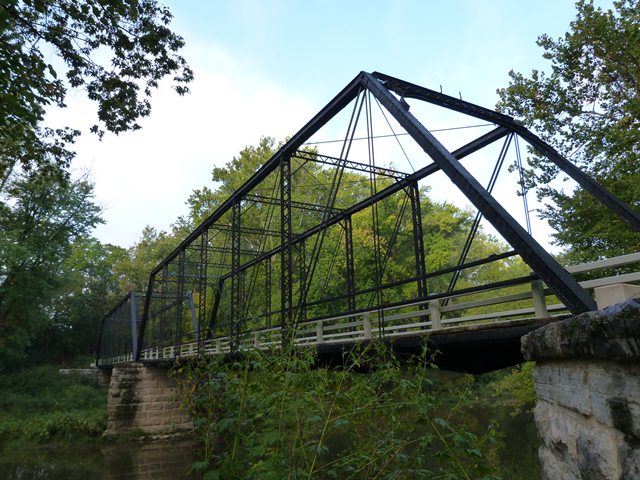We Recommend:
Bach Steel - Experts at historic truss bridge restoration.
BridgeHunter.com Phase 1 is released to the public! - Visit Now
Furnas Mill Bridge
Indiana State Highway Bridge 41-7430

Primary Photographer(s): Nathan Holth and Rick McOmber
Bridge Documented: September 22, 2012
Rural: Johnson County, Indiana: United States
1880 By Builder/Contractor: King Bridge Company of Cleveland, Ohio
2006
119.0 Feet (36.3 Meters)
242.0 Feet (73.8 Meters)
13.5 Feet (4.11 Meters)
2 Main Span(s)
60270

View Information About HSR Ratings
Bridge Documentation
View Archived National Bridge Inventory Report - Has Additional Details and Evaluation
This bridge was reportedly built ca. 1885. Its distinctive decorative portal bracing knees identify it as a product of the prolific King Bridge Company.
This bridge was reported to have been repaired around 1924. This bridge was more recently rehabilitated under a Transportation Enhancement grant for light vehicular use. The project was designed by J. A. Barker Engineering. The bridge retains its attractive built-up fishbelly floor beams. A creative, non-obtrusive method was used to strengthen this bridge. Rather than replacing members, and adding members, steel beams were hidden inside the top chord and end post. Given the box beam nature of the original top chord and end post, this is an excellent solution since the added beams fit into empty space and are quite nicely hidden by the original beams.
This bridge is located in the Atterbury Fish and Wildlife Area and is in a wooded setting. The light traffic the bridge sees and the recreational nature of the area, make this a great bridge to rehabilitate and preserve.
Information and Findings From DHPA Historic Bridge SurveyStatement of Significance A once-prolific Ohio firm probably designed and erected these quite-long and Pratt spans. The crafting of the top chords, endposts, and floor beams suggests that the spans are also very old. The bridge retains its original members, including their decorated portals and bracing. Architectural Description An Ohio firm, probably the King Iron Bridge Company of Cleveland, built this two-span, pin-connected Pratt through structure upon cut stone abutments, wingwalls, and pier. The spans extend 118' and 119', respectively, with eight-paneled trusses. The channels used for the top chords and endposts were crafted to make for heavier and stiffer members than the contemporary off-the-shelf rolled stock allowed. A pair of rectangular eyebars, somewhat smaller towards center-span, are used for lower-chord members. Laced channels, decreasing in size toward midspan, provide the intermediate verticals, and a pair of square eyebars supply the hip-vertical suspenders. Each panel beyond the outer or endpost ones carry a pair of rectangualr eyebars as diagonals, and are countered in the two most central panels with an adjustable square bar. U-bolted to the lower pins, girder floor beams made deeper at center than at the ends carry a concrete deck with a 15'11" roadway. Narrow-channel guardrails protect the trusses. The trusses also carry latticed portals with additionally-decorated bracing. Bridge Considered Historic By Survey: Yes |
![]()
Photo Galleries and Videos: Furnas Mill Bridge
Bridge Photo-Documentation
Original / Full Size PhotosA collection of overview and detail photos. This gallery offers photos in the highest available resolution and file size in a touch-friendly popup viewer.
Alternatively, Browse Without Using Viewer
![]()
Bridge Photo-Documentation
Mobile Optimized PhotosA collection of overview and detail photos. This gallery features data-friendly, fast-loading photos in a touch-friendly popup viewer.
Alternatively, Browse Without Using Viewer
![]()
Maps and Links: Furnas Mill Bridge
Coordinates (Latitude, Longitude):
Search For Additional Bridge Listings:
Bridgehunter.com: View listed bridges within 0.5 miles (0.8 kilometers) of this bridge.
Bridgehunter.com: View listed bridges within 10 miles (16 kilometers) of this bridge.
Additional Maps:
Google Streetview (If Available)
GeoHack (Additional Links and Coordinates)
Apple Maps (Via DuckDuckGo Search)
Apple Maps (Apple devices only)
Android: Open Location In Your Map or GPS App
Flickr Gallery (Find Nearby Photos)
Wikimedia Commons (Find Nearby Photos)
Directions Via Sygic For Android
Directions Via Sygic For iOS and Android Dolphin Browser
USGS National Map (United States Only)
Historical USGS Topo Maps (United States Only)
Historic Aerials (United States Only)
CalTopo Maps (United States Only)

